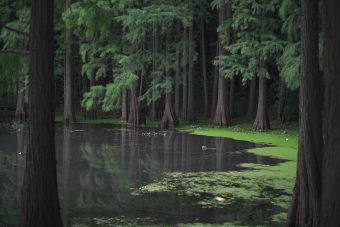This 2020 theme for the International Day of Forests on 21 March is Forests and Biodiversity. It’s an often-quoted fact that forests are home to 80 per cent of terrestrial biodiversity, but did you know that one type of tree also supports marine biodiversity—the mangrove tree?

Awareness is growing among governments and coastal communities in tropical countries of the incredible value of mangroves to nature and humans.
Mangrove trees store more carbon in their rich soils than most other trees, which makes them valuable assets in the fight against global heating. They also buffer storm surges, provide breeding grounds for fish and a host of other marine animals, and serve as effective filtration systems that prevent the influx of saline water which renders soil unfit for agriculture.
Biodiversity is an important ecosystem benefit that mangrove forests provide. Community and biodiversity-based ecotourism in mangroves can help generate incentives for conservation and sustainable management. Tourists have a wide range of options to experience the wonderful biodiversity of mangrove forests, including through boat tours, kayaking, snorkeling, bird watching and nighttime crab fishing. In Madagascar, mangroves are home to lemurs which are among the most threatened group of mammals on Earth. These “swamp lemurs” were documented for the first time just a few years ago.
“Mangrove forests are highly productive ecosystems and their conservation should be the first priority, but where mangroves have disappeared restoration has also proved possible,” says United Nations Environment Programme (UNEP) coastal and marine ecosystems expert Gabriel Grimsditch.
In 2019, the United Nations issued a massive global call to action to mobilize the political and financial support necessary to restore the world’s deforested and degraded ecosystems. The United Nations Decade on Ecosystem Restoration will run from 2021 to 2030 and emphasize scaling-up of restoration work to address the severe degradation of landscapes and forests, including mangroves, our marine blue forests.
Blue forests restoration initiatives
UNEP and partners have recently been involved in successful “mangrove carbon” finance projects in Kenya, and Madagascar under the Blue Forests Project.
These projects link mangrove forests to the global carbon market, with payments for mangrove carbon supporting the planting and conservation of mangrove trees and other benefits to the local communities. UNEP is currently supporting an exploration of how to similarly link seagrass ecosystems to the carbon market in Kenya.
As the world’s only examples of successful community-based mangrove carbon finance projects, the Kenya and Madagascar experiences were profiled last month at the Indian Ocean Blue Carbon Hub Inaugural Think Tank workshop in Mauritius. Results of the workshop included recognition that biodiversity and other ecosystem benefits, including carbon sequestration, are vital for advancing a nature-based healthy blue economy.
In Ecuador, the Blue Forests Project has supported Conservation International’s engagement with the government and local communities in setting up mangrove conservation agreements. Under the “socio manglar” programme, indigenous communities are given economic incentives—based on the rich biodiversity that mangrove’s support—to commit to the conservation and protection of mangrove forests. In this case, the communities gain exclusive use of the red mangrove crab and black cockle, both lucrative national fisheries.
“Restoration is not a quick win. Considerable financial resources and sustained buy-in from local communities over many years are needed for successful restoration projects,” says Isabelle Vanderbeck, a UNEP marine ecosystems expert working closely with the Global Environment Facility on mangrove restoration projects.
A Resolution adopted by the United Nations Environment Assembly on 15 March 2019 “encourages Member States to improve research, education and public awareness, build capacity for the sustainable management and restoration of mangroves and related ecosystems, and, to that end, consider ways in which to mobilize the necessary resources for developing countries.”
What is the Global Environment Facility Blue Forests Project?
The Global Environment Facility International Waters focal area is enabling the Blue Forests Project to provide the first global-scale assessment of how the values of carbon sequestration and other coastal ecosystem services can be harnessed to achieve improved ecosystem management and sustainable communities while mitigating climate change. The project also improves knowledge for informed decision-making, raises awareness, fosters cooperation among all stakeholders, and provides experiences and tools for greater global application.
The United Nations Decade on Ecosystem Restoration 2021–2030, led by the United Nations Environment Programme, the Food and Agriculture Organization of the United Nations and partners such as the Africa Restoration 100 initiative, the Global Landscapes Forum and the International Union for the Conservation of Nature, covers terrestrial as well as coastal and marine ecosystems. A global call to action, it will draw together political support, scientific research and financial muscle to massively scale up restoration. Help us shape the Decade.
Source: UNEP

